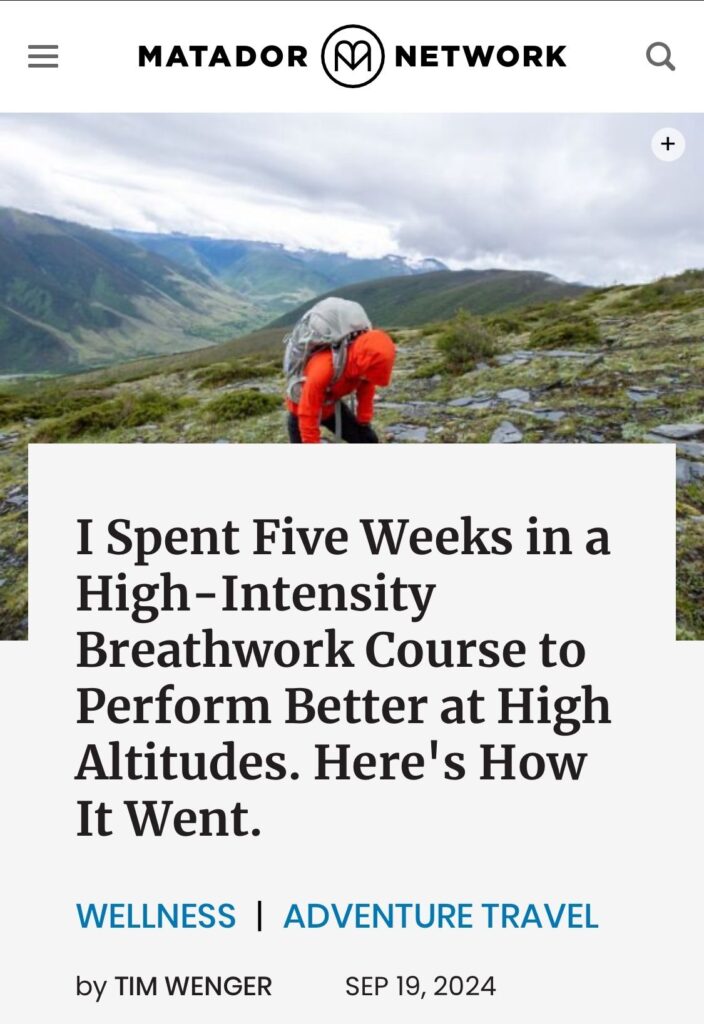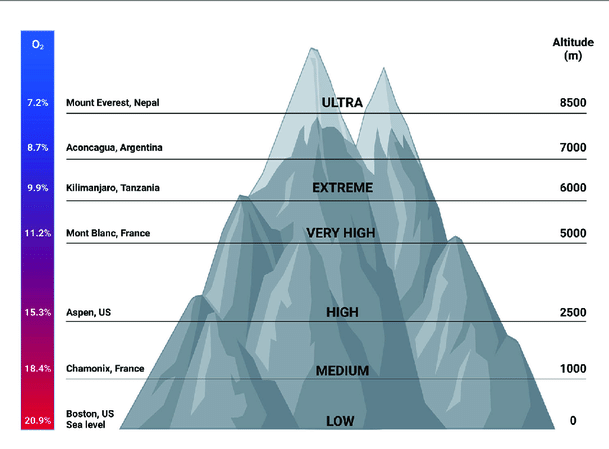
Breathe Stronger. Climb Higher. Go Farther.
Give your ALTITUDE ENDURANCE an edge
High Altitude Breathwork Training is designed to complement your training for the mountain. Whether you’re climbing the Seven Summits, running a mountain race, or attempting to summit a local mountain: improve your endurance at altitude with breathwork training.
And the best part? You can train at any elevation, without major equipment.


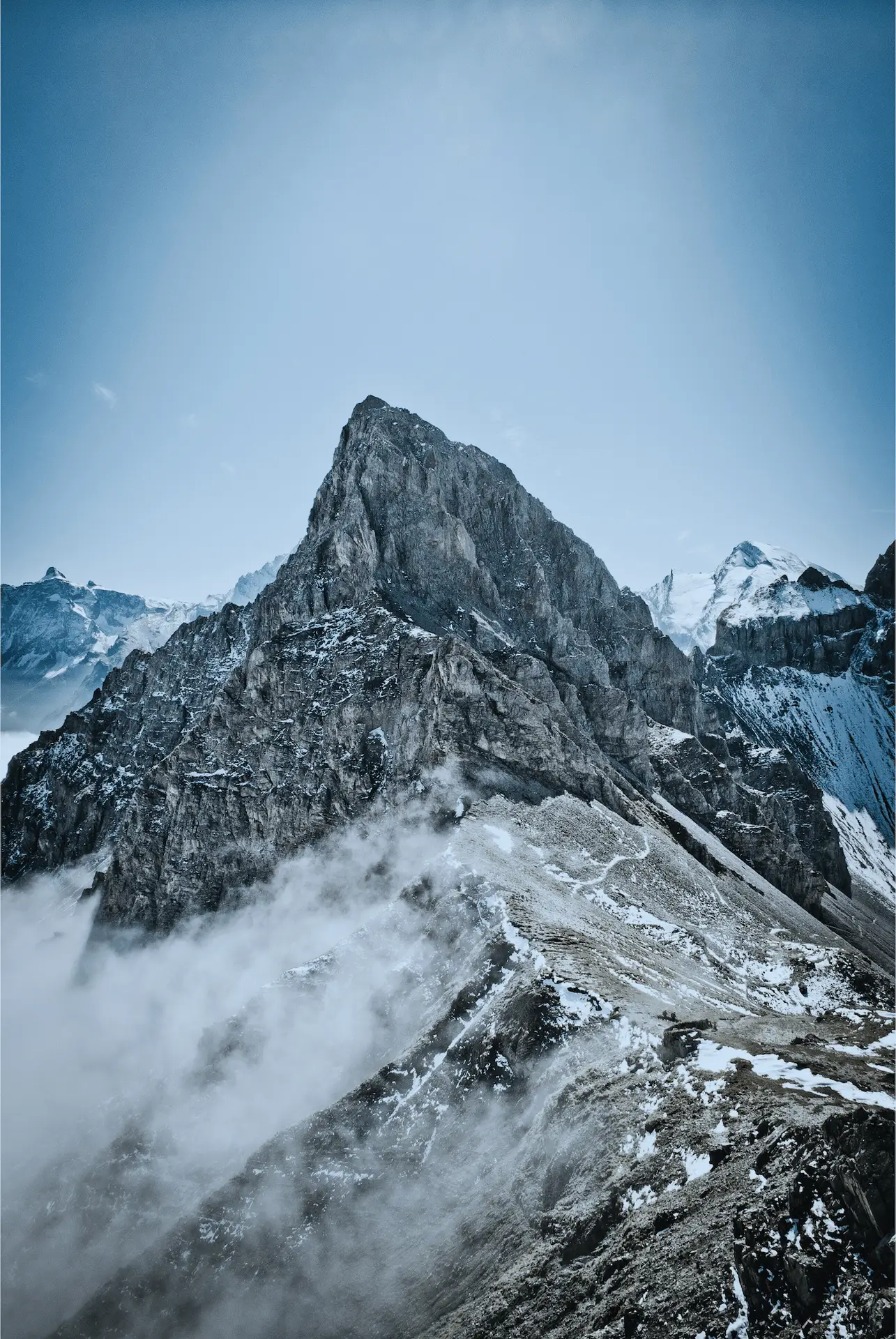
Start training now
- Everything in the video course, PLUS:
- 3 virtual 1-1 training sessions
- Tailored training to fit your needs
- Contact for Pricing
- Week-by-week online course to stay on track
- Video explanations and demos of each exercise
- Insights and advice from your Coach
- Written 5-week training program
- Descriptions of each exercise
- Workbook to track progress
WANT A CLOSER LOOK?
Let’s walk through it as if you’re starting Week 1 of training.
1st: We test your breathing
You will use 3 breath assessment scores to track your progress throughout training:
- Body Oxygen Level Test (BOLT)
- Carbon Dioxide Tolerance Test (CO2TT)
- Maximum Breathlessness Test (MBT)
Watch the video to get your own CO2TT score
2nd: We DEFINE the structure
There are two sides to your Breathwork Training.
- High Altitude Simulation (HAS) Exercises
HAS exercises make adaptations in your body like a higher CO2 tolerance (to feel less breathless) and increased red blood cell count (to increase your oxygen uptake capacity). View the research here.
- Respiratory Muscle Training (RMT) Exercises
RMT exercises strengthen the respiratory muscles (diaphragm, intercostals, and abdomen), which helps to keep your oxygen saturation levels higher at altitude. View the research here.
Watch the video to learn more
3rd: we begin the training
Now, it's time to dive into some exercises. Breathe Light is an exercise designed to train your CO2 tolerance so you can feel less breathless on the mountain — and maintain an efficient breathing pattern when things get challenging.
Watch the video to do Breathe Light
Prep for HAS is one (of four) High Altitude Simulation (HAS) exercises in Week 1. Even though it's a warm-up exercise, it will give you a taste of what's to come.
Watch the video to do Prep for HAS
Exhale Pulsations is one (of two) Respiratory Muscle Training (RMT) exercises in Week 1. This strengthens your abdomen and inner intercostal muscles (the ones you use to exhale), which helps with gas exchange at altitude and keeps your oxygen levels up.
Watch the video to do Exhale Pulsations
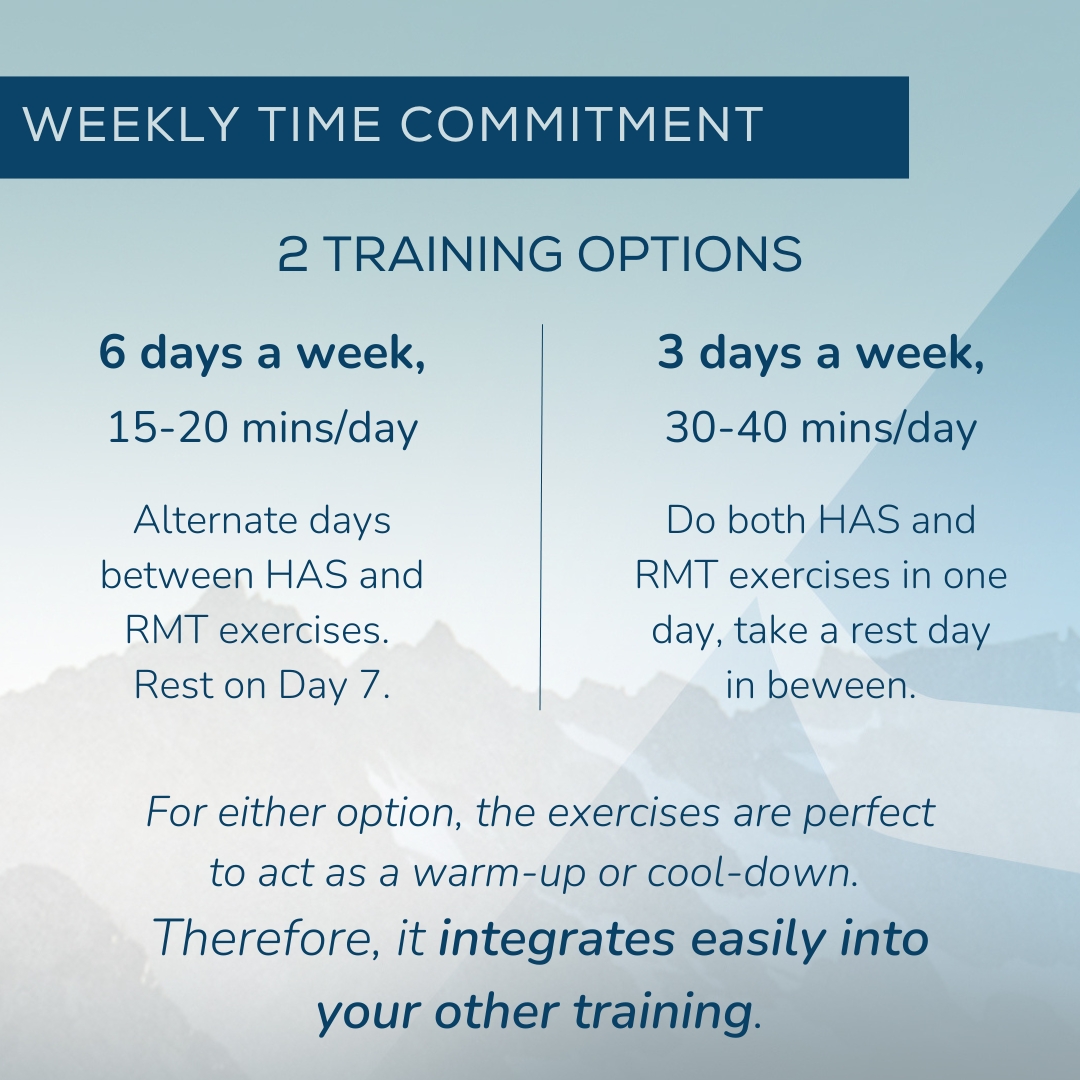
And you're off and running.
All you need to do now is choose how to integrate breathwork into your current fitness training.
Remember, this program is designed to be a complement (in addition) to your other training, and done during the pre-acclimatization block of training, i.e. the last 5 weeks before your endeavor in the mountains.
Ready to build your endurance at altitude?
Choose the best training for you:
Book a free consultation:
Hear from past clients:

Umer L.
Lahore, Pakistan → From 2,300 to 6,050 meters in 4 days, August 2024
Joshua B.
Alaska, USA → Leadville 100 Colorado, USA, August 2024
"I chose to participate in this training because I'm an endurance trail runner living at sea level, well versed in variable terrain and elevation gain, but unfamiliar with running at altitude. Since the training, I’ve seen improvements in my hill climb times and the ability to catch my breath after a steep, fast climb. While training, the biggest thing I gained is the ability to increase my pace while keeping my heart rate in my Zone 2. At Leadville 100, I felt great and performed very well. I believe there's much to gain from this training, whether as a climber, runner or biker."
Gordon H.
Alabama, USA → Bear 100 Ultramarathon, Utah, September 2024
Jennifer F.
Oak Park, IL, USA → Mera Peak, Nepal, October 2024
Tim F.
Pennsylvania, USA → Mt. Rainier, Washington, July 2024
Ron H.
Kansas City, USA → Mt. Cotopaxi, Ecuador, February 2024
Catherine C.
Ontario Canada → Mt. Cotopaxi, Ecuador, February 2024
Dr. Raymundo, MD, IFMGA
International Federation of Mountain Guides Associations
“While guiding individuals who had recently trained with Recal, I was surprised at how well they were feeling – and moving quite fast for being at 5,000 meters – after not having been at any altitude months prior. The program seemed to improve their ability to keep hypoxic levels under control – which we monitored using a pulse oximeter – and an increase in oxygen uptake.
I saw, first-hand, these effects play out and was pleasantly surprised.”
READ THE ARTICLE IN MATADOR.
“You can feel the difference – I did, emphatically. The course taught me to push through what I previously believed to be my breaking point, and on my first long trek through the high alpine, I noticed a significant improvement in my performance.
Bring on the mountains.”
— Tim Wenger, Matador, September 2024
MEet Your Coach
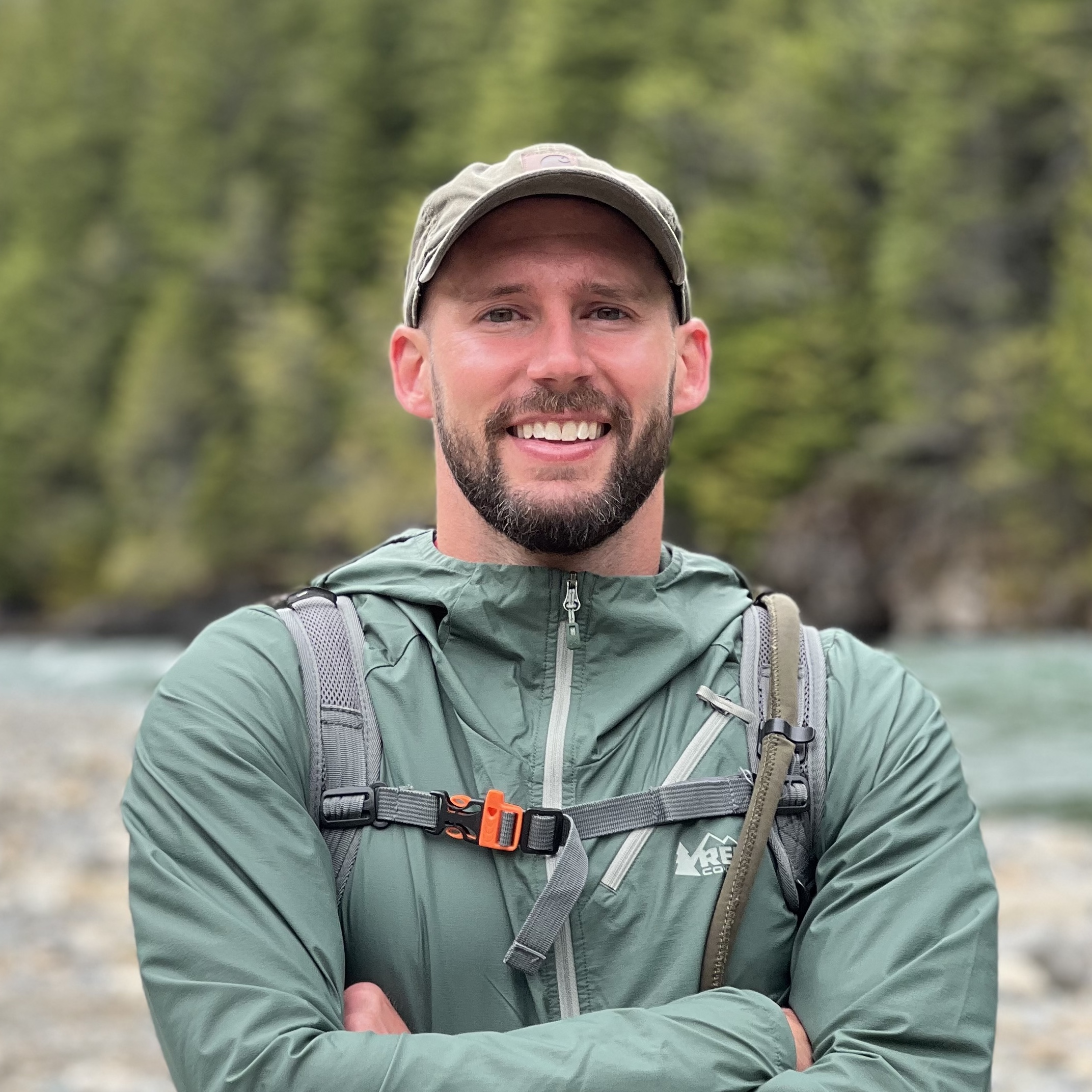
"We created this training to share the breathwork protocols that had been highly researched, but not yet put into a practical program for mountain athletes to use on the actual mountain."
Anthony Lorubbio is the founder of Recal. He is certified in the Oxygen Advantage, Wim Hof Method, and Peak Flow breathwork training modalities. Anthony coaches teams and individuals in applying these and other techniques to prepare for their personal mountain endeavors. He's also passionate about helping adventurous entrepreneurs like himself build mental resilience on—and off—the mountain.
ALTITUDE TRAINING.
FROM ANYWHERE.
So, what happens at altitude?
The partial pressure of oxygen decreases as you climb higher
This decrease in oxygen availability sets off a series of changes to your respiratory system. You may experience an increase in respiratory rate (breaths/min), increased heart rate, and decrease in oxygen uptake (VO2max).
The higher you go, you might face these challenges:
- Low oxygen saturation levels (hypoxia)
- Respiratory muscle fatigue due to thin air and larger workload
- Difficulty maintaining mental clarity
Learn how you can combat these effects with breathwork training.
Hear from Coach Anthony as he explains the science behind your training program:
In short, High Altitude Breathwork Training enables you to:

OPTIMIZE YOUR BREATHING EFFICIENCY

MAKE TARGETED ADAPTATIONS IN YOUR BODY

STRENGTHEN RESPIRATORY MUSCLES
Want to chat?
Book a free consultation:

What the training IS vs IS NOT
“Increasing the oxygen-carrying capacity of the blood is the most important factor when adjusting to an increase in altitude, and breathwork training exercises are an ideal way to prepare in the weeks before ascent.”
—Patrick McKeown, author of The Oxygen Advantage
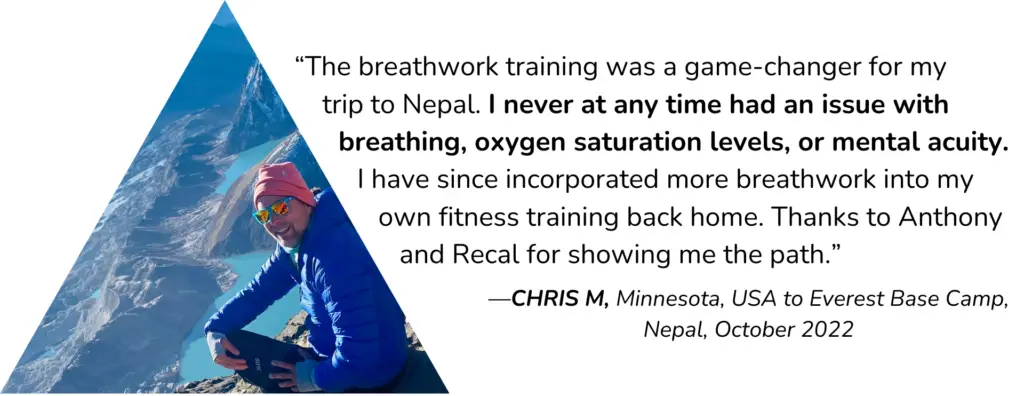
your expedition DOESN'T NEED TO BE MISERABLE
Train with High Altitude Breathwork
Our best-seller is the Online Course.
Lifetime access includes:
- Weekly video modules unpacking Recal's holistic approach, the science of breathwork, and exercises for adapting to the effects of altitude.
- Real-life demonstrations of Recal Founder, Anthony Lorubbio, applying these techniques for his Sea-to-Summit Challenge.
- Daily exercises to improve breathing efficiency, prepare your body for less oxygen and more CO2, strengthen respiratory muscles, and prepare your mind for stressful situations.
- Guided workbook to accompany your training and track progress.
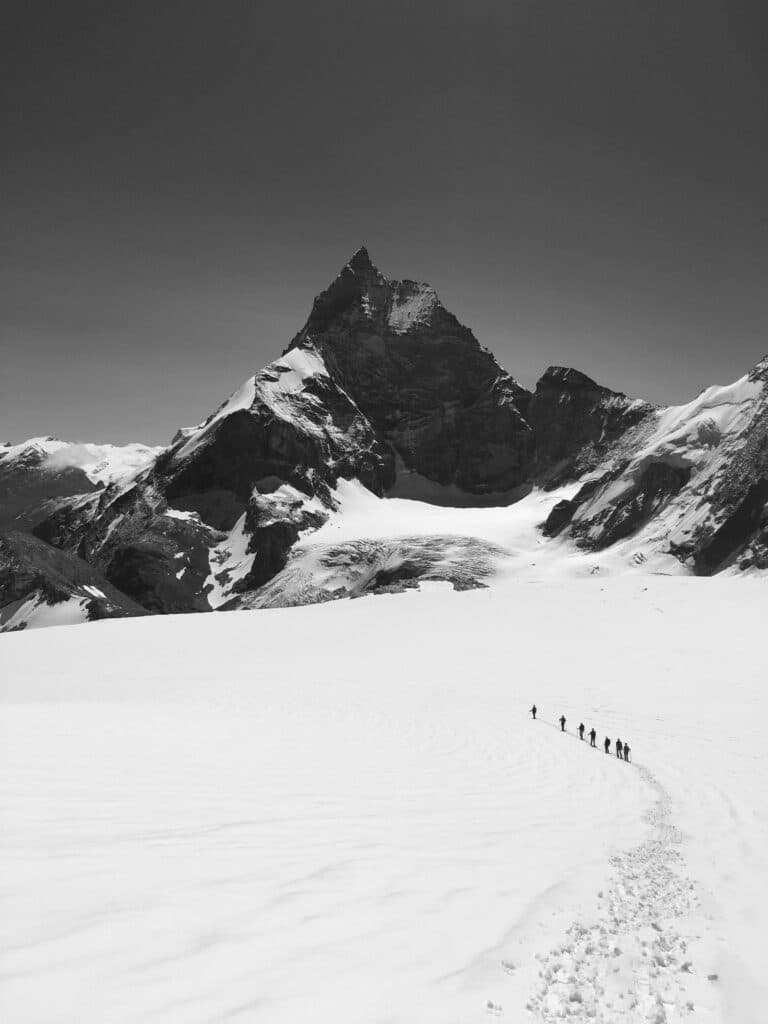
FAQ about the Online Video Course:
High altitude environments have a combination of low air pressure and less oxygen, making it harder to breathe (particularly inhale), and fatigue more quickly. You can also develop hypoxia (low oxygen).
By doing high altitude breathwork training, you can make key changes that will pay off in this environment:
- Strengthening of your respiration muscles, allowing your body to breathe more effectively in the lower air pressure,
- Increase your body’s oxygen uptake capacity (also known as VO2 max) as a result of higher hemoglobin (red blood cell) concentration,
- Train your mind to remain sharp amidst the mental fogginess that comes with altitude, and
- Increase your tolerance for CO2, which will decrease the FEELING of breathlessness at altitude, which enable you to maintain proper breathing habits as things get tough.
A cautionary note: there is no training guaranteed to prevent altitude sickness, but breathwork training can help give you the tools to reduce some effects of the altitude.
Recal’s High Altitude Breathwork Training program was specifically designed to prepare you for trekking at high-altitudes. Based on real-life application by our coaches, the program will strengthen your body and mind using the latest breathwork protocols and evidence-based practices for creating physiological adaptations for altitude.
During the five-week, online program our coaches will help you:
- Understand the effects of high altitude on your body and mind.
- Develop physical fitness tailored for high-altitude environments.
- Adapt your body in a way that will help with altitude – despite training at lower elevations.
- Master essential breathing techniques for high-altitude.
- Navigate the mental challenges and stay focused during your adventure.
Research consistently shows that the mindful application of breathwork can have a positive impact on your life, such as reducing stress and anxiety, improving sleep quality, decreasing fatigue and recovery time after physical activity, boosting your immune system, improving emotional intelligence, and more.
More recently, research (and our own application of the research) has proven that the use of breathwork training can prepare you for high altitude situations.
In this training, we will focus on breathwork for three key reasons:
To improve your breathing efficiency. Improving the efficiency of your breathing is critically important for preventing severe hypoxia (low oxygen) at altitude. Studies show that slow, deep breathing improves blood oxygenation, which is necessary for reducing the effects of severe hypoxia. Our goal with this training is to enable you to keep your breathing rate slow and controlled – which will enhance blood oxygenation.
To create physiological adaptations. This program is designed to simulate high altitude environments – the combination of low oxygen (hypoxia) and high carbon dioxide (hypercapnia) – through breathwork. Exercises, such as breath-holds, will help you mentally and physically prepare for a hypoxic environment and increase your oxygen uptake capacity (VO2 max). Along the way, your body will make adaptations, including the release of erythropoietin (EPO) to create new red blood cells (See: research here). Simultaneously, you will train your CO2 tolerance, which will improve the efficiency of oxygen delivery to your muscle tissues – enabling you to keep going when things get tough.
To increase your respiratory muscle strength. Due to the thinner air at high altitude, your body will have to work harder to get air into the lungs. Therefore, our program incorporates strength training exercises for your diaphragm and intercostal muscles – key muscles used in breathing. Also, we have exercises that incorporate the use of the Oxygen Advantage SportsMask for increased resistance and additional strength training (this is recommended, but not required).
Designed to begin 5-weeks prior to your endeavor, the training begins by establishing a personal baseline for some important breath metrics, including a body oxygen level test, carbon dioxide tolerance test, and maximum breathlessness test. Don’t worry, we go through these in detail in the course.
Each week, you’ll train using protocols to improve these metrics, while also learning breath-based mindfulness practices that will serve you during and after your adventure. You’ll come out of the program more mentally resilient and emotionally intelligent; this is not ‘just’ about altitude.
Week 1: Establish Your Baseline Breath Assessments and Begin with High Altitude Simulation Training
Week 2: Discuss How Breathwork Addresses Altitude Challenges, Build on the Training with Sport-Specific Protocols
Week 3: Continue with the Sport-Specific Protocols, Push for Breath Assessment Improvements
Week 4: Our Most Intense Week, Mental Fitness for High Altitude (and life!)
Week 5: Final Push for Physiological Adaptations In Preparation for the Altitude
The course concludes with a brief training on how to apply proper breathing techniques during your high altitude adventure.
The five-week online program includes:
Weekly video modules unpacking Recal’s holistic approach, the science of breathwork, and exercises to prepare you, your mind, and your body to the realities of high altitude.
Real-life demonstrations of Recal Founder, Anthony Lorubbio, applying the techniques for his own ‘Sea-to-Summit’ Challenge.
Daily exercises to improve breathing efficiency, prepare your body for less oxygen, lower air pressure, and higher blood CO2, strengthen your respiratory muscles, and prepare your mind to stay sharp at altitude and in stressful situations.
A guided workbook to accompany the learning journey and track your progress.
The High Altitude Breathwork Training is $275, which includes access to all training materials and resources for life.
If you would like 1-on-1 guidance specific to your adventure, you have the option to add-on personal coaching support.
Yes. The training is embedded in high altitude simulation breathwork training protocols. You will undergo exercises that simulate a hypoxic (low O2), hypercapnic (high CO2) bodily state. Your elevation has no bearing on the ability to simulate these environments — it is done solely using the breath.
In the end, you will be better adapted to handle the effects of high altitude.
- Strengthening of your respiration muscles, allowing your body to breathe more effectively in the lower air pressure,
- Increase your body’s oxygen uptake capacity (also known as VO2 max) as a result of higher hemoglobin (red blood cell) concentration,
- Train your mind to remain sharp amidst the mental fogginess that comes with altitude, and
- Increase your tolerance for CO2, which will decrease the FEELING of breathlessness at altitude, which will make breathing easier.
Absolutely not.
This training is designed to get your body, blood, muscles, and mind ready to make achieving your goals at altitude 1) attainable and 2) more enjoyable.
However, this is not an acclimatization replacement. We strongly advise you to respect the acclimatization process and advice from local guides and experts.
There is no training that is guaranteed to prevent altitude sickness, but breathwork can help reduce its negative effects. By equipping yourself with adaptations (higher oxygen uptake, higher CO2 tolerance, and a stronger diaphragm), you will have the ability to breathe better at altitude — which has been shown to prevent altitude sickness (aka acute mountain sickness, or AMS).
However, there are other factors to AMS, including your genetic make-up, age, gender, physical condition, hydration level, and pre-existing conditions. This training is simply designed to give you the tools to breathe better at high altitude, which can help combat the effects of altitude.
Still not sure? Book a free consultation:
Or submit the form below and we'll get in touch.






